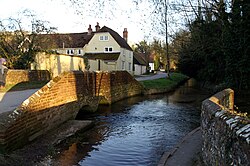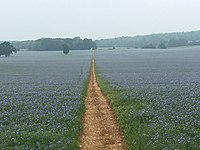Warnford
| Warnford | |
| Hampshire | |
|---|---|
 The Meon in Warnford | |
| Location | |
| Grid reference: | SU624231 |
| Location: | 51°0’14"N, 1°6’35"W |
| Data | |
| Population: | 220 (2001) |
| Post town: | Southampton |
| Postcode: | SO32 |
| Dialling code: | 01730 |
| Local Government | |
| Council: | Winchester |
| Parliamentary constituency: |
Meon Valley |
Warnford is a village in Hampshire, on the A32 in the upper valley of the River Meon in the south-east of the county, between West Meon and Exton.
The parish population in 2019 was estimated at 220.
The village was by-passed by the former Meon Valley Railway (which route now creates the Meon Valley Trail footpath and cycleway).[1] The railway ran down the east of the valley.
The George and Falcon pub and hotel, which is grade II listed and dates to the 16th century,[2] is on the A32 near the centre of the village.
Contents
Parish church
The parish church in the Church of England bears an outlandish dedication for a Reformed church; the Church of Our Lady.[3] It stands in Warnford Park to the south of the village, is Grade I listed.[4]
The church is of Saxon origin, with a Norman west tower of aroud 1130 in the Early English Gothic style. Though essentiall rebuilt in the 12th century, the church contains relics of the Saxon church.
The ruins of the 13th century St John's or King John's House, also Grade I listed, are behind the church. The church and St John's House are accessible via a public footpath from the A32.
History
There is evidence in the form of barrows or burial mounds of occupation from early times. The barrow and associated Saxon boundary bank at Sheepbridge is registered as a Scheduled Monument. Both are referred to in a land charter dating from the time of King Æthelstan. The Domesday Book records Warnford and also Upwarnford, which is believed to have covered the northern part of the parish.
The parish contains a considerable number of other listed buildings, including the farmhouse, well house and granary at Bere Farm, Abbey House (formerly the rectory), North Lodge and the adjacent gateway into Warnford Park, Papermill Cottage and Riversdown House. None of these is open to the public.
On 4 April 1944 a Royal Air Force, Airspeed Horsa I (LG999) was taking part in a training exercise out of RAF Keevil. The glider was being towed by a Short Stirling (LJ842) and during the training the Stirling struck trees. This resulted in the Airspeed Horsa I crashing in the park, killing the two pilots and all 24 paratroopers. To date, the crash remains the second deadliest involving a glider. The Stirling aircraft later crashed near Romsey, killing all six crew.[5][6][7]
About the village
The River Meon flows through the village. In summer the section between West Meon and Warnford is often dry, but there are major springs at Moorhen Trout Fishery and just below it at Warnford Upper Pond, so the river through the village is always in water. There is on the ground evidence of an extensive system of channels fed from sluices in Warnford Upper Pond and higher up the valley at Sheepbridge which fed water to meadows on the west side of the valley. The river flows into the park and feeds a lake, originally the pond for a paper mill close to the A32 at the junction with Peake New Road.
The land rises to an extensive area of chalk plateau to the north and west, extending from Bere Farm across Pinks Hill to the side valley that carries Wheely Down Road. There are beautiful views across the valley from the public footpaths which climb Pinks Hill. The Beacon Hill National Nature Reserve is at the western end of the parish, a chalk hill some 660 feet high flanked by numerous steep-sided dry valleys. Beacon Hill is accessible via the Monarch's Way long-distance footpath which crosses the valley in Warnford.
To the south and east of the village Hayden Lane crosses the old railway line and climbs a spur of the chalk downs to the Old Winchester Hill National Nature Reserve, which is just outside the eastern end of the parish . The South Downs Way links these two nature reserves and shares short sections of the Monarch's Way either side of the parish.
Warnford Park is Grade II listed as a park and garden, but is not open to the public except on Sundays in February when a "snowdrop walk" is opened up in aid of the church, with the permission of the landowner. The park was the site of the manor house, renamed "Belmont" in the 19th Century and demolished in the 1950s. It was requisitioned by the War Office in Second World War and never reoccupied by the owners afterwards.
There are watercress beds owned by Vitacress Ltd at three places in the valley but two of these are currently out of use.
Society and leisure
The village hall close to the centre of the village and was converted from a farm shop, having been earlier a pig farm laboratory. It was given to the village in 1998 by the owner of the Warnford Estate.
Warnford Playground in Lippen Lane was given by the family of R.P. Chester in his memory in 1978 for the benefit of parishioners. It is managed by a charitable trust and open to the public.
Outside links
| ("Wikimedia Commons" has material about Warnford) |
References
- ↑ "Hampshire County Council - Meon Valley Trail". https://www.hants.gov.uk/thingstodo/countryside/finder/meonvalleytrail.
- ↑ George & Falcon
- ↑ Our Lady, Warnford: A Church Near You
- ↑ National Heritage List 1296978: Church of Our Lady, Warnford (Grade I listing)
- ↑ "20th Century History of Warnford - Warnford Village - Warnford Village, Warnford, Southampton". https://www.hugofox.com/community/warnford-village-7802/20th-century-history-of-warnford/#.
- ↑ "Hampshire Aircraft Crashes and Accidents.". https://www.hampshireairfields.co.uk/hancrash.html.
- ↑ "Sgt Henry Thomas Joel". https://www.billericayhistory.org.uk/content/topics/place-2/war-memorials/billericay_war_memorial/second-waorld-war-memorial/memories-sgt-henry-thomas-joel.
- A History of the County of Hampshire - Volume 3 pp 268-273: Parishes: Warnford (Victoria County History)

